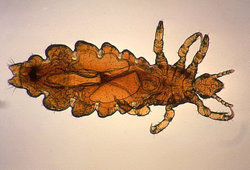Pediculosis
Pediculosis is an infestation of lice -- which are parasitic insects -- on the bodies of humans. The condition is more commonly known as head lice, body lice or pubic lice. more...
Head lice (Pediculus capitis) infestation is most frequent on children aged 3-10 and their families. Females get head lice more often than males, and in the United States, African-Americans have head lice less often. The reasons for these two facts are not known.
Head lice are spread through direct head-to-head contact with an infested person. Body lice are spread through direct contact with the body, clothing or other personal items of a person already carrying lice. Pubic lice are most often spread by intimate contact with an infested person. Head lice occur on the head hair, body lice on the clothing, and pubic lice mainly on the hair near the groin. Human lice do not occur on pets or other animals. Lice do not have wings and cannot jump.
From each egg or "nit" may hatch one nymph that will grow and develop to the adult louse. Full-grown lice are about the size of a sesame seed. Lice feed on blood once or more often each day by piercing the skin with their tiny needle-like mouthparts. Lice cannot burrow into the skin.
Head lice and body lice (Pediculus humanus) are similar in appearance, although the head louse is often smaller. Pubic lice (Pthirus pubis), on the other hand, are quite distinctive. They have shorter bodies and pincer-like claws, making them look like crabs (hence, the nickname for pubic lice: "crabs").
The most common symptom of lice infestation is itching. Excessive scratching of the infested areas can cause sores, which may become infected. In addition, body lice can be a vector for louse-borne typhus, louse-borne relapsing fever or trench fever.
Lice on the hair and body are usually treated with medicated shampoos or cream rinses. Nit combs can be used to remove lice and nits from the hair. Laundering clothes using high heat can eliminate body lice. Efforts to treat should focus on the hair or body (or clothes), and not on the home environment.
Some lice have become resistant to certain (but not all) insecticides used in commercially available anti-louse products. A physician or pharmacist can prescribe or suggest treatments. Because empty eggs of head lice may remain glued on the hair long after the lice have been eliminated, treatment should be considered only when live (crawling) lice are discovered. Children with nits should not be sent home from school.
Read more at Wikipedia.org



